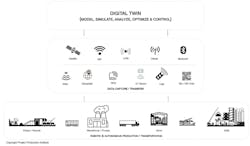By Todd Zabelle, Founder and President, Strategic Project Solutions Inc. (SPS)
Offshore oil and gas projects are experiencing significant supply chain challenges, which can have a material impact on project performance. Offshore supply chains are complex from fabrication to installation, hookup and commissioning. Brownfield projects are particularly difficult to supply with discovery of issues during execution that must be addressed. Therefore, it is essential to understand what it means to configure and operate project supply chains efficiently and effectively.
But first, let’s establish some common ground about what we mean by supply chains in the context of offshore projects. They are a system of interconnected production and inventory systems providing needed materials and services. Configuration decisions include what to buy from suppliers and service providers, what to make, how to make it, who should make it and where should it be made.
There are six minimum requirements for an effective supply chain:
1. Reliable partnerships
Inbound resources must be delivered when needed and in accordance with quality specifications. In advanced industries, such as automotive, original equipment manufacturers work in partnership with suppliers to ensure they are able to meet technical and volume requirements. Improving products, process design and reducing lead time are all elements of these partnerships.
2. Transparent supply process
Project leaders can see at any given time where materials are located. Early delivery cannot be tolerated offshore with the scarcity of space, because this could result in late and expensive crews, vessels and cranes sitting idle, etc. The advent of the Internet of Things, artificial intelligence and machine learning, coupled with satellites, offers a significant improvement in transparency. These technologies enable real-time location and environment tracking for better control of the supply process.
3. Redundancy
Measures should be in place to protect disruption resulting from industrial actions, revisions in demand, equipment breakdowns, weather and other sources. Toyota is well known for the use of two suppliers in most categories with one supplier receiving 80% of the volume and the other 20%. An offshore project may have a second vessel on call to mitigate disruptions with the primary vessel supplier at critical times.
4. Agility / flexibility
Demand often changes for a variety of reasons. An effective supply chain must be able to adopt to changes in demand without excessive cost. To achieve agility and increase flexibility, excessive amounts of inventory in the supply chain must be identified and removed. This may be counterintuitive to project leaders. Stacks of inventory can increase the time required to make changes. Buffer strategies, including what type of buffer is adequate (capacity and/or inventory), along with where in the supply process buffers are placed and how much, must also be carefully considered.
5. Cost efficiency
Supply chains must operate efficiently and at best value. This can only be achieved through an end-to-end value stream perspective, where supply is seen as a dynamic system, not a low bid transaction. This can be optimized using production system modeling, simulation and analysis methods.
6. Inventory
None of this is possible if the supply chain does not have the right amount of capacity and inventory. Inventory includes stock (i.e., what they buy/store) and work-in-process (i.e., what they make).
Too much work-in-process (WIP) results in extended cycle times with additional cash tied up and reduced agility. Too little WIP results in insufficient output to meet the demand. Furthermore, too much stock results in unnecessary cash tied up, while not having the right combination, and most often results in project delays.
Efficient and effective offshore project supply chains don’t just happen. There are a series of strategies (e.g., operate based on optimal WIP levels) and methods (e.g., supplier programs, production system modeling) that will enable project teams to ensure their supply chains are reliable, transparent, agile, flexible and cost efficient.
About the author: Todd R. Zabelle is the founder and CEO of Strategic Project Solutions. He has more than 30 years of experience in the delivery of complex and critical capital projects. He was the founder and president of Pacific Contracting, an equity partner in the Lean Construction Institute, and founder of the Project Production Institute.




